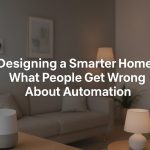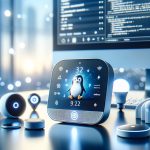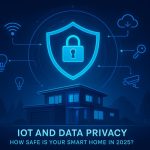Smart homes were once science fiction, but today they’re a reality in millions of households. With voice assistants, smart plugs, and automated lighting systems, it’s easy to assume home automation is simply a matter of plugging in a few devices. Yet, many homeowners quickly discover that “smart” doesn’t always mean simple.
In this article, we’ll explore the most common mistakes people make when automating their homes — and how to design a system that’s not only connected but truly intelligent.
1. Focusing on Gadgets Instead of Systems
One of the biggest pitfalls in home automation is buying devices without considering how they’ll work together. A home full of disconnected “smart” products isn’t a smart home — it’s a collection of apps and remotes.
The key is integration. A good smart home setup should have a central ecosystem, whether that’s Google Home, Alexa, Home Assistant, or Apple HomeKit. This ensures devices communicate seamlessly, enabling routines like:
“When I arrive home, unlock the door, turn on the lights, and play music.”
Without integration, you end up with frustration — and a drawer full of unused gadgets.
2. Ignoring Network Stability
Smart homes depend on one thing above all else: a strong, stable Wi-Fi network. Many people underestimate how much bandwidth their connected devices need, especially when using multiple cameras, sensors, and hubs.
Tips for a reliable network:
- Use mesh Wi-Fi systems for large homes.
- Separate IoT devices on a guest network for security.
- Keep your router updated and positioned centrally.
Without this foundation, even the smartest automation will fail.
3. Forgetting About Privacy and Security
Every connected device is a potential entry point for hackers. Yet, too many users skip the basic security steps.
Best practices include:
- Changing default passwords immediately.
- Keeping firmware up to date.
- Avoiding cheap, no-name devices that don’t offer security updates.
A truly smart home doesn’t just automate — it protects.
4. Over-Automating Everything
Just because something can be automated doesn’t mean it should be. Many users fall into the trap of automating every tiny action, only to end up with a confusing, overcomplicated system.
Good automation feels natural. Lights that turn on when you enter a room make sense; coffee makers that trigger from motion sensors in another room probably don’t. The goal is effortless living, not constant tinkering.
5. Ignoring the Human Element
A smart home must fit the people who live in it. Automation should adapt to your lifestyle — not the other way around.
For instance:
- Families with kids might prioritize security and energy savings.
- Elderly users might value voice controls and fall detection.
- Tech enthusiasts might prefer open-source platforms for customization.
When planning automation, start with habits, not hardware.
6. Not Planning for Scalability
Most homeowners start small — maybe a smart bulb or thermostat — but fail to think long term. As technology evolves, you’ll want to add more devices, integrate new systems, and upgrade components.
Choose open standards like Zigbee, Z-Wave, or Matter to ensure future compatibility. That way, your investment continues to pay off as your home evolves.
7. Neglecting Data and Insights
Smart homes generate vast amounts of data: temperature patterns, energy usage, lighting schedules, and more. Ignoring this data means missing out on what truly makes a home intelligent — learning and optimization.
Modern systems can automatically adjust lighting based on your daily routine or lower heating costs during unoccupied hours. The smartest homes are those that analyze your behavior to improve comfort and efficiency.
Final Reflection
Building a smart home isn’t about collecting the latest gadgets — it’s about creating harmony between technology and everyday living.
When you focus on integration, security, and genuine convenience, automation stops being a novelty and becomes something much more meaningful: a home that learns, adapts, and simplifies your life.
Linux and the Internet of Things: Powering the Smart Future
- Designing a Smarter Home in 2026: What People Get Wrong About Automation
 Smart homes were once science fiction, but today they’re a reality in millions of households. With voice assistants, smart plugs, and automated lighting systems, it’s easy to assume home automation is simply a matter of plugging in a few devices. Yet, many homeowners quickly discover that “smart” doesn’t always mean simple. In this article, we’ll…
Smart homes were once science fiction, but today they’re a reality in millions of households. With voice assistants, smart plugs, and automated lighting systems, it’s easy to assume home automation is simply a matter of plugging in a few devices. Yet, many homeowners quickly discover that “smart” doesn’t always mean simple. In this article, we’ll… - Automated Online Trading: How IoT is Redefining Financial Markets
 Introduction automated online trading In a world where milliseconds can decide millions, the fusion of Internet of Things (IoT) technology and automated online trading is reshaping global finance. What once relied solely on human judgment now increasingly depends on connected machines, real-time data, and predictive algorithms. From weather sensors influencing agricultural trades to smart logistics…
Introduction automated online trading In a world where milliseconds can decide millions, the fusion of Internet of Things (IoT) technology and automated online trading is reshaping global finance. What once relied solely on human judgment now increasingly depends on connected machines, real-time data, and predictive algorithms. From weather sensors influencing agricultural trades to smart logistics… - The Role of Linux in IoT: Powering the Connected World
 The Internet of Things (IoT) is everywhere—from smart homes and wearable devices to industrial automation and self-driving cars. Behind the scenes, one operating system plays a surprisingly dominant role: Linux. Known for its stability, flexibility, and open-source nature, Linux has become the backbone of countless IoT devices and platforms. But what makes Linux so well-suited…
The Internet of Things (IoT) is everywhere—from smart homes and wearable devices to industrial automation and self-driving cars. Behind the scenes, one operating system plays a surprisingly dominant role: Linux. Known for its stability, flexibility, and open-source nature, Linux has become the backbone of countless IoT devices and platforms. But what makes Linux so well-suited… - The Smart Home Revolution in 2025: How IoT is Transforming Everyday Living
 In the past decade, the vision of a truly smart home has moved from futuristic fantasy to everyday reality. As we step into 2025, the Internet of Things (IoT) has matured into a robust ecosystem, connecting appliances, security systems, lighting, and even entertainment devices under one seamless digital roof. The result? Homes that are safer,…
In the past decade, the vision of a truly smart home has moved from futuristic fantasy to everyday reality. As we step into 2025, the Internet of Things (IoT) has matured into a robust ecosystem, connecting appliances, security systems, lighting, and even entertainment devices under one seamless digital roof. The result? Homes that are safer,… - IoT and Data Privacy: How Safe Is Your Smart Home in 2025? – IoT Security
 The smart home revolution has made everyday life more convenient than ever. From voice assistants that control the lights to security cameras that send alerts directly to your phone, connected devices have become part of our daily routines. But with this convenience comes an important question: how safe is your personal data in a world…
The smart home revolution has made everyday life more convenient than ever. From voice assistants that control the lights to security cameras that send alerts directly to your phone, connected devices have become part of our daily routines. But with this convenience comes an important question: how safe is your personal data in a world…





